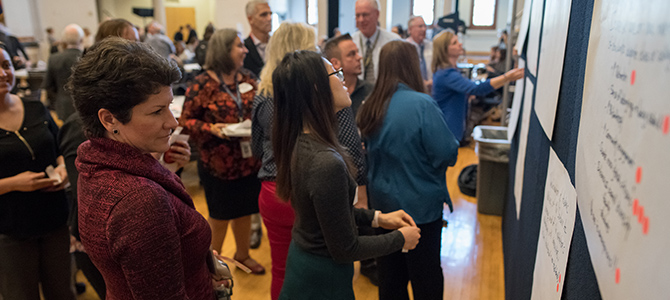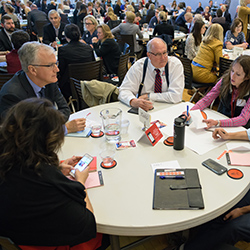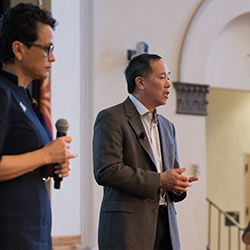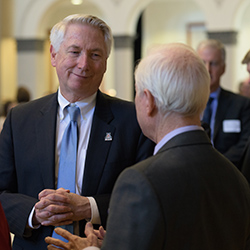
University of Arizona Strategic Planning Event Draws 200 to the Downtown Phoenix Campus


Nearly 200 people shared their thoughts about the University of Arizona's future during an interactive strategic planning event held on the Phoenix Biomedical Campus last week.
"Your input today is going to be really important to us," UA President Robert C. Robbins told the faculty members, staff, students and community members who gathered at the College of Medicine – Phoenix, which is located on the historic Phoenix Union High School campus.
Robbins began calling for a new strategic plan shortly after he became president in June. The Phoenix event, held March 6, was part of his commitment to an inclusive process that draws on feedback from people inside and outside the University to create a roadmap for the next 10-20 years. Robbins also has emphasized the potential for the UA to be a leader in what is called the Fourth Industrial Revolution, which is characterized by a convergence of the digital, biological and physical sciences.
The president was joined at the Phoenix event by the co-chairs for the strategic plan, Elliott Cheu, associate dean and distinguished professor in the College of Science, and Lisa Ordóñez, vice dean and professor in the Eller College of Management.
In the past few months, Robbins, the co-chairs and others involved in leading the strategic plan process have connected with more than 4,000 people, including members of the UA community, alumni, donors, civic leaders and others throughout the state.
"We have done a lot of listening," Ordóñez said, adding that there are many people who are very passionate about the University and "all the amazing things that are going on."
The Phoenix event was modeled after an interactive session held on the UA's main campus on Jan. 29, with participants using their smartphones to give real-time feedback to a series of questions.

- What word best describes the strengths of the University of Arizona?
- What word should define the University of Arizona 10 years from now?
- In a word, what makes you most proud to be a Wildcat?
Participants also were asked to work in groups to collectively create a vision for the UA. Each table was asked to agree on a single idea. The ideas were then posted around the room, and participants voted by placing stickers next to the ideas they liked most.
The event ended with a Q&A with Robbins, Ordóñez and Cheu, who shared more context about the strategic planning process.
Previous Plan
The UA's most recent strategic plan, known as Never Settle, had many good outcomes, such as 100 percent student engagement and cluster faculty hires, Ordóñez said. Unlike that plan, she said, the new plan will "drill down" to the college and department level.
Undergraduate Education
The plan likely will call on the UA to think "big and bold" when it comes to undergraduate education, designing core courses to emphasize those skills that are in increasing demand, such as leadership, problem solving, critical thinking and digital literacy, Cheu said.
Phoenix Biomedical Campus

More collaboration around cutting-edge research is needed "for us to be on the map" and create an environment that attracts Fortune 100 companies in the biomedical sciences, Robbins said.
Implementing the Strategic Plan
The plan will be presented to the Arizona Board of Regents in November.
Once it is finalized, "we will be measuring on a quarterly basis" and allocating the resources needed to achieve the goals outlined in the plan, Robbins said.
Student Experience
Another area that will be addressed in the plan is increasing the number of freshmen who return for their sophomore year, Ordóñez said.
"We need to focus on not only getting them to the University of Arizona, but keeping them here," she said.
Next Steps
"Meetups" are being held this month to delve into the ideas that have emerged in the focus groups, campus visits and meetings held thus far, as well as the feedback submitted via the strategic plan website. One will be held on the Phoenix Biomedical Campus, where participants will consider how the UA can create solutions that help people age with dignity. More information about the March 22 event. Virtual meetups also are being planned.
Also coming up are visits to colleges, where faculty and staff will be invited to share their thoughts about the strategic plan. The dates for the visits will be posted on the strategic plan website.
In addition, feedback is being collected on the strategic planning website, which is being updated regularly with questions and prompts. Share your thoughts.
Article by: Pila Martinez, University Communications
Media Contact:
Marian Frank
Phone: 602-827-2022
Topics
About the College
Founded in 2007, the University of Arizona College of Medicine – Phoenix inspires and trains exemplary physicians, scientists and leaders to advance its core missions in education, research, clinical care and service to communities across Arizona. The college’s strength lies in our collaborations and partnerships with clinical affiliates, community organizations and industry sponsors. With our primary affiliate, Banner Health, we are recognized as the premier academic medical center in Phoenix. As an anchor institution of the Phoenix Bioscience Core, the college is home to signature research programs in neurosciences, cardiopulmonary diseases, immunology, informatics and metabolism. These focus areas uniquely position us to drive biomedical research and bolster economic development in the region.
As an urban institution with strong roots in rural and tribal health, the college has graduated more than 1,000 physicians and matriculates 130 students each year. Greater than 60% of matriculating students are from Arizona and many continue training at our GME sponsored residency programs, ultimately pursuing local academic and community-based opportunities. While our traditional four-year program continues to thrive, we will launch our recently approved accelerated three-year medical student curriculum with exclusive focus on primary care. This program is designed to further enhance workforce retention needs across Arizona.
The college has embarked on our strategic plan for 2025 to 2030. Learn more.